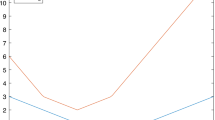Abstract
This paper proposes a new tabu search algorithm for multi-objective combinatorial problems with the goal of obtaining a good approximation of the Pareto-optimal or efficient solutions. The algorithm works with several paths of solutions in parallel, each with its own tabu list, and the Pareto dominance concept is used to select solutions from the neighborhoods. In this way we obtain at each step a set of local nondominated points. The dispersion of points is achieved by a clustering procedure that groups together close points of this set and then selects the centroids of the clusters as search directions. A nice feature of this multi-objective algorithm is that it introduces only one additional parameter, namely, the number of paths. The algorithm is applied to the permutation flowshop scheduling problem in order to minimize the criteria of makespan and maximum tardiness. For instances involving two machines, the performance of the algorithm is tested against a Branch-and-Bound algorithm proposed in the literature, and for more than two machines it is compared with that of a tabu search algorithm and a genetic local search algorithm, both from the literature. Computational results show that the heuristic yields a better approximation than these algorithms.
Similar content being viewed by others
References
Armentano, V.A. and D.P. Ronconi. (1999). “Tabu Search for Total Tardiness Minimization in Flowshop Scheduling Problems.” Computers and Operations Research26, 219–235.
Arroyo, J.E.C. and V.A. Armentano. (2004). “A Partial Enumeration Heuristic for Multi-Objective Flowshop Scheduling Problems.” Journal of the Operational Research Society55, 1000–1007.
Baykasoglu, A., S. Owen, and N. Gindy. (1999). “A Taboo Search Based Approach to Find the Pareto Optimal Set in Multiple Objective Optimization.” Engineering Optimization31, 731–748.
Ben Abdelaziz, F., S. Krichen, and J. Chaouachi. (1999). “An Hybrid Metaheuristic for the Multiobjective Knapsack Problem.” In S. Voss, S. Martello, I. Osman, and C. Roucairol (Eds.), Meta-Heuristics-Advances and Trends in Local Search Paradigms for Optimization. Kluwer, pp. 205–212.
Coello, C.A.C. (1999). “A Comprehensive Survey of Evolutionary-based Multiobjective Optimization.” Knowl-edge and Information Systems1, 269–308.
Daniels, R.L. and R.J. Chambers. (1990). “Multiobjective Flow-Shop Scheduling.” Naval Research Logistics37, 981–995.
Ehrgott, M. and X. Gandibleux. (2000). “A Survey and Annotated Bibliography of Multicriteria Combinatorial Optimization.” OR Spektrum22, 425–460.
Gandibleux, X., N. Mezdaoui, and A. Fréville. (1997). “A Tabu Search Procedure to Solve Multiobjective Com-binatorial Problems.” In R. Caballero, F. Ruiz, and R. Steuer (Eds.), Advances in Multiple Objective and Goal Programming, vol. 455 of Lecture Notes in Economics and Mathematical Systems. Springer, pp. 291–300.
Gandibleux, X. and A. Fréville. (2000). “Tabu Search Based Procedure for Solving the 0-1 Multiobjective Knapsack Problem: The Two Objectives Case,” Journal of Heuristics6, 361–383.
Glover, F. and C. McMillan. (1986). “The General Employee Scheduling Problem: An Integration of Management Science and Artificial Intelligence.” Computers and Operations Research15, 563–593.
Glover, F. (1989). “Tabu Search-Part I.” ORSA Journal on Computing1, 190–206.
Glover, F. (1990). “Tabu Search-Part II.” ORSA Journal on Computing2, 4–32.
Glover, F. and M. Laguna. (1997). Tabu Search. Kluwer.
Hansen, M.P. (2000). “Tabu Search for Multiobjective Combinatorial Optimization: TAMOCO.” Control and Cybernetics29, 799–818.
Hansen, M.P. and A. Jaszkiewicz. (1998). “Evaluating the Quality of Approximations to the Nondominated Set.” Technical Report, Institute of Mathematical Modelling (1998-7), Technical University of Denmark.
Hansen, M.P. (2000). “Use of Substitute Scalarizing Functions to Guide a Local Search Based Heuristic: The Case of moTSP.” Journal of Heuristics6, 419–431.
Holland, J.H. (1975). Adaptation in Natural and Artificial Systems. University of Michigan Press.
Ishibuchi, H. and T. Murata. (1998). “A Multi-Objective Genetic Local Search Algorithm and its Application to Flowshop Scheduling.” IEEE Transactions on Systems, Man and Cybernetics-Part C: Applications and Reviews 28, 392–403.
Jones, D.F., S.K. Mirrazavi, and M. Tamiz. (2002). “Multi-Objective Meta-Heuristics: An Overview of the Current State-of-the-Art.” European Journal of Operational Research137, 1–9.
Kirkpatrick, S., C.D. Gellat Jr., and M.P. Vecchi. (1983). “Optimization by Simulated Annealing.” Science220, 671–680.
Lourenço, R.H., J.E. Paixão, and R. Portugal. (2001). “Multiobjective Metaheuristics for the Bus Driver Scheduling Problem.” Transportation Science35, 331–343.
Morse, J.N. (1980). “Reducing the Size of the Nondominated Set: Pruning by Clustering.” Computers and Oper-ations Research7, 55–66.
Nawaz, M., E.E. Enscore, and I. Ham. (1983). “A Heuristic Algorithm for the m-Machine, n-Job Flowshop Sequencing Problem.” OMEGA11, 91–98.
Potts, C.N. and L.N. Van Wassenhove. (1982). “ADecomposition Algorithm for the Single Machine Total Tardiness Problem.” Operations Research Letters1, 177–181.
Steuer, R.E. (1986). Multiple Criteria Optimization-Theory, Computation and Application.Wiley.
Taillard, E. (1993). “Benchmarks for Basic Scheduling Problems.” European Journal of Operational Research 64, 278–285.
Ulungu, E.L., J. Teghem, and Ch. Ost. (1998). “Efficiency of Interactive Multi-Objective Simulated Annealing Through a Case Study.” Journal of the Operational Research Society49, 1044–1050.
Van Veldhuizen, D.A. and G.B. Lamont. (2000a). “Multiobjective Evolutionary Algorithms: Analysing the State-of-Art.” Evolutionary Computation8, 125–147.
Van Veldhuizen, D.A. and G.B. Lamont. (2000b). “On Measuring Multiobjective Evolutionary Algorithm Perfor-mance.” 2000 Congress on Evolutionary Computation,vol. 1. Piscataway, New Jersey, pp. 204–211.
Viana, A. and J.P. Pinho. (2000). “Using Metaheuristics in Multiobjective Resource Constrained Project Schedul-ing.” European Journal of Operational Research12, 359–374.
Author information
Authors and Affiliations
Rights and permissions
About this article
Cite this article
Armentano, V.A., Claudio, J.E. An Application of a Multi-Objective Tabu Search Algorithm to a Bicriteria Flowshop Problem. Journal of Heuristics 10, 463–481 (2004). https://doi.org/10.1023/B:HEUR.0000045320.79875.e3
Issue Date:
DOI: https://doi.org/10.1023/B:HEUR.0000045320.79875.e3




